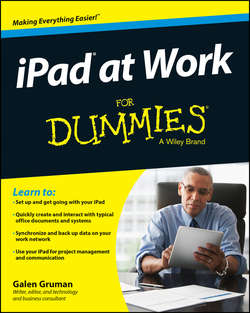Читать книгу iPad at Work For Dummies - Galen Gruman - Страница 7
На сайте Литреса книга снята с продажи.
Part I
Getting Started with iPad at Work
Chapter 2
Setting Up Your Own iPad for Work
Choosing between iTunes Backup and iCloud Backup
ОглавлениеEveryone should back up his or her iPad, but if you use an iPad for work, you have an extra measure of responsibility to ensure that your settings and other data are backed up so that you can retrieve them if your iPad is wiped, damaged, lost, or stolen, minimizing the downtime for you and your business.
The pros and cons of each backup option
Apple has designed the iPad so that it can work without ever connecting to a computer, using iCloud to back up key information. An iPad can also connect to a computer via iTunes, which gives it more capabilities. And even if you do connect your iPad to your computer’s iTunes, you have a choice of where you back up the iPad’s data: to iTunes or to iCloud.
The pros of backing up to iCloud are that the backup occurs anywhere you are, as long as you have Internet access through a Wi-Fi connection and your iPad is connected to a power source. Each day, the iPad will back up photos and videos in the Photos app’s Camera Roll, your device settings, your apps’ data (but not their files), your Home screen organization, all your text messages (iMessage, and – if your iPad has a cellular radio – SMS and MMS), and ringtones.
The pro of backing up to iTunes is that in addition to everything that is backed up to iCloud, iTunes also transfers all the files stored by apps on your iPad. Plus, if you enable encrypted backup in iTunes, all your passwords are backed up as well. As with iCloud backup, the iPad backs up automatically once each day. But for iTunes backup to work, both your iPad and iTunes on your computer have to be running, and the two devices need to be connected via a USB cable or both need to be on the same Wi-Fi network.
Whichever backup method you use, Apple stores for you, on its own servers, any iTunes, App Store, and iBooks purchases, as well as any documents stored in iCloud Drive. That means that these items can be restored no matter what backup method you choose and even if your iPad hasn’t been backed up.
As you can see, an iTunes backup stores more but requires that you use iTunes on a computer. If you’re on the road a lot, you might go weeks without a backup. Or your company might disable iTunes access on your iPad as part of its mobile device management policies (see Chapter 3), so you can’t use iTunes.
Setting your backup choice
Apple doesn’t let the iPad back up to both iTunes and iCloud, so you have to make a choice, unfortunately. Only you can decide the best backup location. Here’s where you apply the decision you make:
✔ In iTunes on your computer, select your USB– or Wi-Fi–connected iPad from the Devices list, go to the Summary pane, and select either iCloud or This Computer (for iTunes). To enable Wi-Fi backup for iTunes, also select the Sync with This iPad over Wi-Fi option. Likewise, to enable encrypted iTunes backup, also select the Encrypt iPad Backup option.
✔ On your iPad, go to the Settings app, tap iCloud, tap Backup, and then set the iCloud Backup switch to On to enable iCloud backup and Off to enable iTunes backup.
You can change this backup choice at any time. What you can’t do is have both types of backup enabled at the same time.
Manually back up your iPad
Even though your iPad will back up daily if it has a connection to the Internet or to iTunes, you can back up the iPad at any time.
For iTunes backup, select your iPad from the Devices pop-over in iTunes and click Sync to manually back up your iPad. On the iPad, go to the Settings app, tap General, tap iTunes Wi-Fi Sync, and then tap Sync Now. (If Sync Now is grayed out, make sure that iTunes is running on your computer and is connected to the same Wi-Fi network as your iPad. The button should become active when those conditions are met.)
For iCloud backup, go to the Settings app, tap iCloud, tap Backup, and then tap Back Up Now. To see and control what is backed up to iCloud, go to the Settings app, tap General, tap Usage, tap Manage Usage in the iCloud section, and tap your iPad’s name to get the screen shown below.
